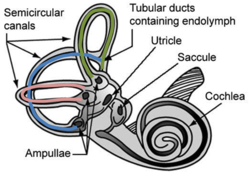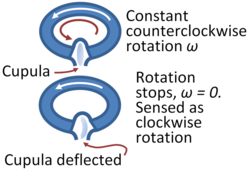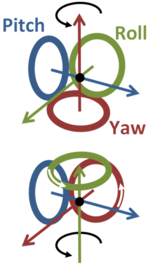Coriolis effect: Difference between revisions
imported>John R. Brews |
imported>Gareth Leng |
||
| Line 67: | Line 67: | ||
{{Image|Cupula deflection.PNG|right|250px|When the semicircular canal stops rotating, inertia causes the cupula to register a false rotation in the opposite sense.}} | {{Image|Cupula deflection.PNG|right|250px|When the semicircular canal stops rotating, inertia causes the cupula to register a false rotation in the opposite sense.}} | ||
{{Image|Pitch Roll Yaw.PNG|left|150px|''Top'': The semicircular canals with head erect. ''Bottom'': the canals with head tipped forward.}} | {{Image|Pitch Roll Yaw.PNG|left|150px|''Top'': The semicircular canals with head erect. ''Bottom'': the canals with head tipped forward.}} | ||
The ''vestibular system'' of the ear senses | The ''vestibular system'' of the [[inner ear]] senses motion and body position, and is very important for maintaining balance. The three ''semicircular canals'' observe angular acceleration in the three planes of motion: ''pitch'' (nod ''yes''), ''yaw'' (twist your head ''no''), and ''roll'' (pivot head from left to right shoulder without twisting). The ''otolith organs'', that is, the ''utricle'' and the ''saccule'' detect linear acceleration and the tilt of the head.<ref name=NASA> | ||
An introduction to the workings of the vestibular system is found at {{cite web |url=http://weboflife.ksc.nasa.gov/learningResources/humanVestibularSystem.htm |publisher=NASA: Exploration systems mission directorate education outreach |title=The effects of space flight on the human vestibular system |accessdate=2011-02-17 |work=Document EB-2002-09-011-KSC}} | An introduction to the workings of the vestibular system is found at {{cite web |url=http://weboflife.ksc.nasa.gov/learningResources/humanVestibularSystem.htm |publisher=NASA: Exploration systems mission directorate education outreach |title=The effects of space flight on the human vestibular system |accessdate=2011-02-17 |work=Document EB-2002-09-011-KSC}} | ||
| Line 73: | Line 73: | ||
</ref> | </ref> | ||
The semicircular canals | The semicircular canals are filled with a fluid, called the ''endolymph''. With angular acceleration, the endolymph presses unequally upon the two sides of a membrane, the ''cupula'', causing it to be deflected. The endolymph action lags the motion of the canal itself, due to its inertia. Under clockwise acceleration of the canal, the endolymph lags the canal, leading to a relative counterclockwise essure on the cupula that is interpreted correctly as a clockwise acceleration. | ||
If angular motion is held constant, a steady state is reached where the endolymph and the canal are moving at the same rate, the cupula no longer deflects, and the motion is not sensed. This situation is shown in the upper panel of the figure. If now the rotation abruptly stops, the canal stops rotating but the endolymph takes time to adapt, leading to a relative counterclockwise rotation of the endolymph. That counterclockwise relative rotation correctly indicates the acceleration, but leads to the false sensory interpretation of rotation in the opposite direction to what previously prevailed, even though actually all motion has stopped. The situation is shown in the bottom panel. | If angular motion is held constant, a steady state is reached where the endolymph and the canal are moving at the same rate, the cupula no longer deflects, and the motion is not sensed. This situation is shown in the upper panel of the figure. If now the rotation abruptly stops, the canal stops rotating but the endolymph takes time to adapt, leading to a relative counterclockwise rotation of the endolymph. That counterclockwise relative rotation correctly indicates the acceleration, but leads to the false sensory interpretation of rotation in the opposite direction to what previously prevailed, even though actually all motion has stopped. The situation is shown in the bottom panel. | ||
Revision as of 07:14, 19 February 2011
In psychophysical perception, the Coriolis effect, also referred to as the Coriolis illusion, is a form of disorientational distress that can lead to nausea.[1][2] The Coriolis effect is a particular concern of pilots, where it can cause extreme discomfort and incorrect responses to maneuver an airplane.[3][4][5][6]
Vestibular system
The vestibular system of the inner ear senses motion and body position, and is very important for maintaining balance. The three semicircular canals observe angular acceleration in the three planes of motion: pitch (nod yes), yaw (twist your head no), and roll (pivot head from left to right shoulder without twisting). The otolith organs, that is, the utricle and the saccule detect linear acceleration and the tilt of the head.[7]
The semicircular canals are filled with a fluid, called the endolymph. With angular acceleration, the endolymph presses unequally upon the two sides of a membrane, the cupula, causing it to be deflected. The endolymph action lags the motion of the canal itself, due to its inertia. Under clockwise acceleration of the canal, the endolymph lags the canal, leading to a relative counterclockwise essure on the cupula that is interpreted correctly as a clockwise acceleration.
If angular motion is held constant, a steady state is reached where the endolymph and the canal are moving at the same rate, the cupula no longer deflects, and the motion is not sensed. This situation is shown in the upper panel of the figure. If now the rotation abruptly stops, the canal stops rotating but the endolymph takes time to adapt, leading to a relative counterclockwise rotation of the endolymph. That counterclockwise relative rotation correctly indicates the acceleration, but leads to the false sensory interpretation of rotation in the opposite direction to what previously prevailed, even though actually all motion has stopped. The situation is shown in the bottom panel.
Mechanism
The mechanism behind the Coriolis effect is related to head motions that reorient the three semicircular canals while a person is rotating, as shown in the left figure. If the head is vertical, and rotation is about the vertical axis, the semicircular canal in the horizontal plane registers the rotating motion. If rotation continues, a steady state is reached where the cupula is not deflected and the rotation is not sensed. If now the head is tilted forward, for simplicity say by 90°, then the yaw canal becomes vertical and this canal is no longer in rotation; its endolymph begins to slow down to match the motion of its canal. The subject then perceives this effect as counter-rotation about a horizontal axis, although actually no motion is occurring. At the same time, the roll canal previously in a vertical plane is brought into a position where it must register the rotation, and its endolymph accelerates. The combined effect of all three semicircular canals is to produce an apparent rotation in a direction unrelated to what is actually happening. It causes a sensation of rolling or yawing that is the Coriolis effect.[8]
Notes
- ↑ Jeffrey W. Vincoli (1999). Lewis' dictionary of occupational and environmental safety and health. CRC Press, p. 245. ISBN 1566703999.
- ↑ George Mather (2006). Foundations of perception. Taylor & Francis. ISBN 0863778356.
- ↑ Arnauld E. Nicogossian (1996). Space biology and medicine. Reston, VA: American Institute of Aeronautics and Astronautics, Inc, p. 337. ISBN 1563471809.
- ↑ Thomas Brandt (2003). Vertigo: Its Multisensory Syndromes. Springer, p. 416. ISBN 0387405003.
- ↑ Bob Cheung (2004). “Nonvisual illusions in flight”, Fred H. Previc, William R. Ercoline, eds: Spatial Disorientation in Aviation. Reston, VA: American Institute of Aeronautics and Astronautics, Inc, p. 248. ISBN 1563476541.
- ↑ Gilles Clément (2003). Fundamentals of Space Medicine. Springer, p. 41. ISBN 1402015984.
- ↑ An introduction to the workings of the vestibular system is found at The effects of space flight on the human vestibular system. Document EB-2002-09-011-KSC. NASA: Exploration systems mission directorate education outreach. Retrieved on 2011-02-17.
- ↑ Jeffrey R. Davis, Robert Johnson, Jan Stepanek (2008). Fundamentals of Aerospace Medicine, 4rth ed. Lippincott Williams & Wilkins, p. 175. ISBN 0781774667.


